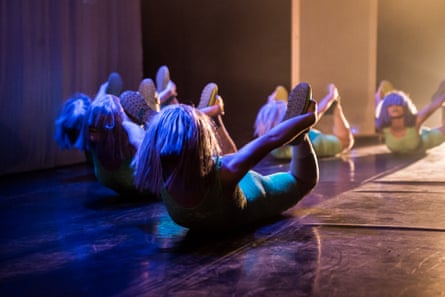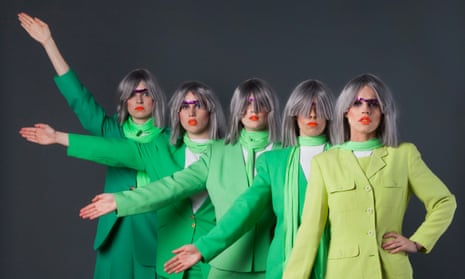How to describe the joy of watching people dancing in unison? Anthropologists talk about synchronous activities leading to a sense of “collective effervescence”; that lightness we feel when we’re all moving together in time – doing the macarena, maybe, or the YMCA – and trace it back to the need to bond members of a family or a tribe to one another, to reinforce the sense of unity that would have once been essential for survival.
The first thing I knew about Figs in Wigs was that they liked to dance in unison. A quintet of identically dressed performers, they appeared whenever the evening got weird enough at Latitude festival or London’s Royal Vauxhall Tavern. They wore DayGlo jumpsuits and matching bum bags, deadpan stares, glittery painted-on monobrows. Watching Figs in Wigs dance was like listening to an alien language, a semaphore of hops and hand gestures that existed at the midpoint between Yvonne Rainer’s Trio A and Saturday Night by Whigfield. Dances made of pixels rather than steps. And like any act of synchronous dancing, there was a satisfaction to be had in watching people moving together in unison, but with Figs, there was always something more: the thrill of how audaciously they constructed their own way of dancing, their own way of being on stage together.
Figs in Wigs are not really a dance troupe. While there is dance in their shows, there is also acting (sort of), comedy (sort of), celebrity impersonation (sort of), and occasionally some homemade electro-punk (sort of). Yet the same surreal internal logic that structures the way they dance extends into every facet of the show. It is present in their bewildering aesthetic choices, in their jokes, in the affectless demeanour with which they approach the increasingly absurd situations their shows create, like five brightly coloured cartoon characters unable to see anything strange about the fact they have somehow ended up in the real world. It is even there in the structuring of the shows, which seem to follow a logic entirely of their own devising. Like a story told by a seven year old, they are full of false starts, extended diversions and endless repetitions. Scenes of unpredictable length crash delightedly into one another like the Figs themselves, endlessly careering across the stage. Yet none of this feels careless or accidental. It is all part of the singular world that Figs are perpetually in the process of constructing for themselves.

All these facets of Figs’ onstage presence amount, in performance, to an expanded version of the feeling you get watching them dance together in unison. It is thrilling in its strangeness, illuminated from within by a collective effervescence, so that even when what’s happening feels shambolic or indecipherable it has a logic you want to understand. It is a world you want to be a part of.
And this is what is so special about Figs in Wigs. At a time when the financial constraints necessitated by a decade of austerity have caused independent theatre to become, on the whole, smaller and more conventional in form and process, Figs have fought on, for close to a decade, making the biggest, most ambitious work they could. They have done so in the same uncompromisingly collaborative way, entirely by collective agreement, without a director or a writer or really any significant outside influence at all. In doing so, they have been able to create something unique – a delirious theatrical universe without precedent, a world unto itself.
In this world the most ordinary and miserable parts of reality are transformed into things ridiculous and spectacular. In their recent show Little Wimmin, they take the arguably quite dour task of faithfully adapting the novel Little Women and turn it into a dizzying parade of surrealist props: an ice fountain in the shape of a penis; a person disguised as a Christmas tree; a giant margarita cocktail, complete with five oversized straws. Their work is an act of appropriation. It is the transformation of the reality that surrounds them into a world they might want to live in. A place of strangeness and colour, of sophisticated theory and childish jokes, of care and community and endless, flocking patterns of movement.
If you have ever been in a protest march, you have probably thought or been told that it won’t change anything. That the message isn’t clear, or is unrealistic. But I think that often it is the marching itself that is the point. We march as a reaffirmation of community and solidarity, creating in the process a space we can all live in together, even if only temporarily. And when we leave we take the feeling of that space with us, allowing the memory of it to illuminate our future actions, changing those actions for the better.

Figs in Wigs shows don’t appear to make much sense. Like a protest march they are bright and loud, occasionally chaotic and lacking any obvious message. And like a protest march, to critique them based on a perceived failure to communicate anything would be a misunderstanding of what is taking place. Each Figs in Wigs show is a reaffirmation of the beguiling universe they are creating for themselves. They are not asking that we decode their strangeness, or even expecting that we find it funny. Instead they are hoping that the world they have created might extend temporarily outwards to include the rest of us. That we can slip into the same odd rhythm. That we can harbour in the shelter of their strangeness from all the awfulness of the contemporary world – its competitiveness, its narcissism, its grim economic reality.
On theatre stages and in cabaret bars, in five matching versions of an infinity of costumes, they continue to act with the absolute conviction that they can live inside a world they have created for themselves, and that perhaps we can, too. And that in itself is a defiantly, gloriously radical act.
This is an edited extract from Performance in an Age of Precarity: 40 Reflections by Maddy Costa and Andy Field, published by Methuen Drama. The Little Wimmin script is available from Salamander Street.

Comments (…)
Sign in or create your Guardian account to join the discussion